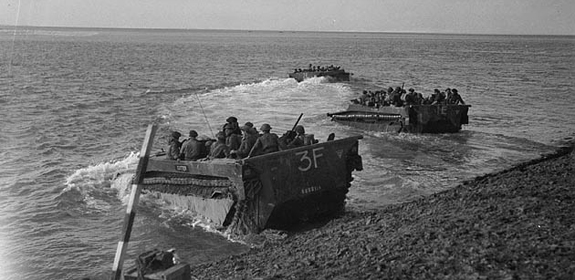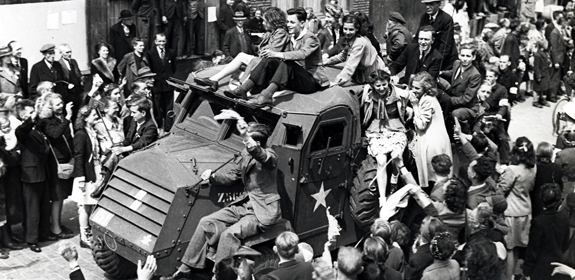The Liberation of the Netherlands
This publication is available upon request in alternate formats.
PDF Version
The events of the past have a direct impact on the world we know today. The warm relationship that exists between Canada and the Netherlands can be traced back to difficult days at the end of the Second World War when Canada played a key role in liberating the people of the Netherlands.
Occupied Europe
The Second World War influenced the lives of countless millions of people, including those who left home to fight in uniform and those who endured great suffering when the fighting took place in their homeland.
In Europe, country after country had fallen to the advances of Hitler's Germany. By mid-1940, much of the west of the continent, including the Netherlands, was under German control. On June 6, 1944, the Allied forces embarked on the struggle to liberate ‘Fortress Europe' from the west with the greatest combined military operation in history: D-Day. The Allies would soon advance north and east out of France, but the Netherlands, with its challenging terrain of canals, dykes and floodlands, coupled with the determined German occupiers, would prove to be a punishing place to battle.
The Battle of the Scheldt
In the months following D-Day, the Allies needed a reliable way to keep supplies flowing to their forces on the European continent. To do this, they required a good seaport. The Belgian port of Antwerp was captured almost intact but it lay almost 80 kilometres from the sea and was accessible only by a long estuary whose shores were controlled by German forces. Much of this coastal area was Dutch and, in the fall of 1944, the First Canadian Army led the way in fierce combat under harsh conditions to clear the German occupiers from the shores of the Scheldt River and open the waterway to vital shipping. More than 6,000 Canadian soldiers were killed, wounded or captured in this gruelling but victorious campaign that became a key step in the liberation of northwest Europe and the end of the war.
The Netherlands' "Hunger Winter"
In the fall of 1944, the Allies launched Operation Market-Garden, a daring land and airborne attack behind enemy lines in the eastern Netherlands. The goal was to bring the war to a rapid end by cutting in half the German positions in western Europe. The German resistance was fierce, however, and the bold offensive failed. It became apparent that the war would not end in 1944.
This would mean many more months of suffering for the Netherlands, which had already endured years of German occupation. The "Hunger Winter" of 1944-45 was a terrible time for the Dutch people. Food supplies were exhausted; many people were reduced to eating tulip bulbs just to try to survive. Fuel had run out and transportation was almost non-existent. By 1945, the official daily ration per person in the Netherlands was only 320 calories, about an eighth of the daily needs of an average adult. Thousands of Dutch men, women, and children perished of starvation and cold.
Canal by Canal, House by House
After three months of holding the front line in the Netherlands, the Canadians joined the final push to liberate the country. In February 1945, the First Canadian Army joined the Allies in a fierce push through mud and flooded ground to drive the Germans eastward out of the Netherlands and back across the Rhine.
In early April, the First Canadian Army began to clear the Germans from the northeast of the country. Often aided by information provided by Dutch resistance fighters, Canadian troops rapidly moved across the Netherlands, recapturing canals and farmland as they drove for the North Sea. Canadians also began to advance in the western Netherlands, which contained the major cities of Amsterdam, Rotterdam and The Hague. British and Canadian forces cleared the city of Arnhem in just two days by fighting a house-by-house battle. Only days later, they cleared Apeldoorn.
Canadian forces were prepared to continue their push in the west of the country, however, there were concerns this would prompt the now-desperate Germans to breach all the dykes and flood the low-lying country. To ease the pressure, and allow for a truce in late April, the Canadian advance in the western Netherlands came to a temporary halt. This allowed relief supplies to reach Dutch citizens who had almost reached the end of their endurance. To show their appreciation to the Canadians who air-dropped food during this time, many Dutch people painted, “Thank you, Canadians!” on their rooftops.
Through the hard work, courage and great sacrifices of Canadian and other Allied soldiers, the remaining German forces in the country surrendered on May 5, 1945, finally liberating all of the Netherlands. All German forces would surrender May 7, 1945. The next day was declared Victory in Europe (V-E) Day.
A Joyous Welcome
The Dutch people cheered Canadian troops as one town after another was liberated. This was a memorable time for the people of the Netherlands. Recalled one Dutch civilian who was a teenager at the time of the Canadian liberation of The Hague: “As the (Canadian) tank came nearer...there was a big hush over all the people, and it was suddenly broken by a big scream, as if it was out of the earth. And the people climbed on the tank...and they were crying. And we were running with the tanks and the jeeps all the way into the city.”
Sacrifice
The fighting in the Netherlands was often bitter but ultimately the Canadians were able to liberate the Dutch people and help bring the Second World War to an end in Europe. This victory, however, came at a terrible cost. More than 7,600 Canadians died in the efforts to free the country and are buried far from their homes and loved ones. Others returned home with injuries to body and mind that they carried for the rest of their lives.
The Legacy
The great bravery and sacrifice of Canadians were not the only help our country gave the Netherlands during the war. Some members of the Dutch royal family found sanctuary in Canada during the war and Princess Margriet was born in Ottawa in 1943. These powerful connections helped form warm bonds of friendship and respect between the Dutch and the Canadians which continue to this day. Evidence of this enduring connection may be seen in the tulips—gifts from the Netherlands—which bloom in Ottawa each spring and in the care and attention bestowed by the Dutch people on the burial places of our war dead. Even though the cost of lives was heavy and the sacrifice great, Canadians are proud to have been cast in the role of liberators.
Canada Remembers Program
The Canada Remembers Program of Veterans Affairs Canada encourages all Canadians to learn about the sacrifices and achievements made by those who have served—and continue to serve—during times of war and peace. As well, it invites Canadians to become involved in remembrance activities that will help preserve their legacy for future generations.
- Date modified:

